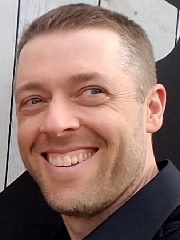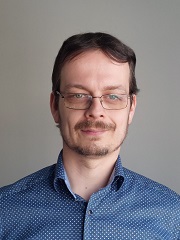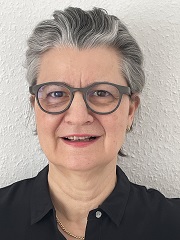Keynotes
LL-13 features four keynotes by internationally acclaimed researchers.
Klick on the first button below ('Alles einblenden') to unfold all info boxes at once.
David Malinowski (San Jose State University)
Resurfacing the public: An inquiry into the civic power of schools and learning in Linguistic Landscape Studies

David Malinowski is Assistant Professor in Applied Linguistics and TESOL at San José State University. With a Ph.D. in Education from the University of California at Berkeley, he teaches and conducts research on teacher development, place-based language teaching, and technology-enhanced language learning. Recent publications include the edited volumes Language Teaching in the Linguistic Landscape: Mobilizing Pedagogy in Public Space (Springer, 2020; with Hiram Maxim and Sébastien Dubreil) and Reterritorializing Linguistic Landscapes: Questioning Boundaries and Opening Spaces (Bloomsbury, 2020; with Stefania Tufi). He currently serves as Associate Editor for the journal Linguistic Landscape.
Abstract
The last decade of linguistic landscape research has shown great advances toward realizing Shohamy and Waksman’s vision that “LL can serve as a powerful tool for education, meaningful language learning, towards linguistic activism” (2009, p. 326). From studies of initiatives to develop students’ and new teachers’ critical awareness of—and activist interventions within—the diverse languages, cultures, and power relations in their neighborhoods (e.g., Burwell & Lenters, 2015; Gorter, Cenoz, & van der Worp, 2021; Niedt & Seals, 2020), to research on the formative, controlled, and ideologically-loaded learning environments that are schoolscapes (Brown, 2012; Krompák, Fernández & Meyer, 2021; Laihonen & Szabó, 2018), to reflective analyses of pedagogical design in LL-based language teaching and learning projects (Malinowski, Maxim, & Dubreil, 2020; Solmaz & Przymus, 2021), researchers have demonstrated that approaching LL as an educational arena opens up unique possibilities for interpreting, analyzing, transforming, and teaching discourses in place.
To this survey of teachers’ and learners’ growing contributions to the field, this keynote adds an empirical survey of its own, in an effort to demonstrate that studying semiotic landscapes in educational spaces offers a particular opportunity to interrogate a definitional aspect of LL as a field of research. To wit, who or what constitutes the public of public signs (if “Linguistic Landscape” is, as Spolsky 2020 glosses it, “the semiotics of public signage”), and what possibilities does the LL hold to cultivate new forms of civic awareness in an ideologically divided, post-pandemic world?
I report on an ongoing study that combines multimodal discourse analysis with field observation, interviews, and spatial narrative (cf. Bodenhamer, Corrigan & Harris, 2015), focused around the signage of approximately 40 public elementary, middle, and high schools in the Santa Clara Valley of California. The signs under analysis are large, changeable displays that greet people entering or passing by the school grounds with messages about school schedules, events, student and teacher accomplishments, and—particularly visible during the pandemic—health-related information, slogans, and appeals for perseverance through months of school closure. In particular, the paper’s analysis accounts for the affective stances and regimes of the signs (cf. Wee, 2016) as indicators of collective authorship and plural audiences of students, parents, and the broader community. Situated on or near the boundary between schools and their surrounding neighborhoods, school welcome signs are evocative evidence of the heteroglossic assemblages from which individual utterances emerge, and the momentary publics that the linguistic landscape call into being—convergences of people, places, and events that an educational stance helps to reveal.
Elana Shohamy (Tel Aviv University)
Linguistic landscape in education: a process for effective critical awareness, activism, and change for societal justice and equity

Dr. Elana Shohamy is a Professor of Multilingual Education at Tel Aviv University, where she teaches and researches multiple issues in sociolinguistics with a focus on social justice, equality and inclusion in education and society, as these are manifested in the domains of Linguistic Landscape (LL), Language Policy and Language Testing. Elana, w/ N. Trumper Hecht and S. Waksman organized the first linguistic landscape conference in Tel Aviv, in 2008. Elana wrote numerous articles and two edited books on Linguistic Landscape: LL in the city (w/ E. Ben Rafael and M. Barni, 2010) and Linguistic Landscape: Expanding the scenery (w/ D. Gorter, 2009). Elana is the current editor w/ Robert Blackledge) of the journal Linguistic Landscape (Benjamins).
Abstract
Linguistic Landscape (LL) is a ‘person for all seasons’; its research touches a variety of fields such as policy, economics, societies, geography, and more. Language and semiotics are all around us, ready to be studied and interpreted. Its findings point to biases and discrimination in public space, as manipulated by powerful organizations that use and abuse public space to promote their biased agendas. For many years the public space had been overlooked and ignored by educational systems, which frame schools as safe spaces, whereas textbooks tend to present public space as a dangerous place. Yet, it is claimed here that cities and other types of ecologies need to be learned, taught, and protested against. There is an urgent need to bring the public space to schools, and for students and teachers to learn how to read and interpret society through the lense of public space. This keynote will offer an overview of a decade of intensive research aiming to promote students’ understanding and critique of the diverse messages which are delivered in the public space. By documenting, experiencing and analyzing LL in diverse neighborhoods, students reassess their feelings of belonging to a city that does not include their languages. Using methods such as photo-voices, they produce emotional narratives about these messages (Hayik 1997). Using metaphors, they gain deep understanding of manipulative advertisements and commercials. I also report on a novel method where students observe the public space and select LL items – linguistic and semiotic – which they perceive as unjust and discriminatory. They then virtually modify the signs so they become inclusive, just and fair, and accompany this with a written explanation for these changes. The results of this study show how different groups interpret the LL according to their specific backgrounds and identities. Altogether, LL in its broader sense – including words and images, movements and sounds – provide thorough lenses for gaining understanding of the public space, but also become critical leading actions for constructive changes, and thus contribute to social justice.
Tamás Péter Szabó (University of Jyväskylä)
Studying schoolscapes as part of international teacher education programmes

Tamás Péter Szabó serves as Senior Lecturer of Multilingualism and the Internationalization of Teacher Education in the Department of Teacher Education at the University of Jyväskylä, and Adjunct Professor of Linguistic Landscape Studies in the Centre for Applied Language Studies at the same university. He has led several research and educational development projects and published extensively on schoolscapes, multilingual and language aware education, educational language policies and creativity in teachers’ professional learning. He has co-led FORTHEM Multilingualism in School and Higher Education Lab, a transnational multidisciplinary multi-stakeholder expert network that facilitates co-creation among academics, university students and university-external stakeholders.
Abstract
An ever-growing collection of studies (e.g., papers in Laihonen and Szabó 2018; Krompák et al. 2022; and Malinowski et al. 2022) has explored the linguistic landscape of education in diverse societal, cultural, interactional, technological, and pedagogical contexts. This field of linguistic landscape inquiry is often labelled with the term schoolscape that emerged from Brown’s (2005) seminal study. Translating research evidence into pedagogical applications, recent publications (e.g., Solmaz and Przymus 2021) support educators in implementing educational activities that are tightly linked to the critical interpretation and innovative design of schoolscapes.
As a follow-up of an earlier account (Szabó 2020), this presentation discusses a novel course, “Multilingual learning environments”, which will be offered by FORTHEM, a European Universities Alliance of nine universities. Situated in the intersection of several study programs of education, this course was developed for bachelor’s and master’s level students of nine European universities as an output of FORTHEM Alliance’s Multilingualism in School and Higher Education Lab, a transnational multi-stakeholder expert network dedicated to societal challenges of multilingual education. Members of a team of 21 people, academics and students of the Lab, have worked in tight collaboration when developing and reviewing the course materials.
This course aims at making the systematic reflection on and research-based design of schoolscapes an integral part of pedagogical practices, and thus at developing university students’ analytical skills and theoretical knowledge on multilingual learning environments as well as raising their awareness to the importance of schoolscapes. The mission of the course is to help future educators in co-creating safe and inclusive environments for learning in diverse societal and disciplinary contexts. That is, the course goes beyond the discussion of using schoolscapes in language education and targets the development of multilingual pedagogies, independently from the subject content.
The course is organized in four modules that cover theoretical and methodological issues of schoolscape studies through research examples. While learning independently and in teams, students investigate environments that are custom-designed for learning (e.g. schools, libraries, museums, playgrounds, etc.) as well as those that are not designed primarily for educational purposes but offer affordances for learning (e.g. streets, shops, apartments, restaurants, etc.).
Besides presenting the structure and content of the course, this presentation discusses insights gained from a survey among course-developing team members. The survey results show how students and academics shared their diverse expertise and experience and how they conceptualized and exemplified schoolscape-related issues though the novel collaborative course design process in the FORTHEM Lab environment.
Evelyn Ziegler (University of Duisburg-Essen)
Political Graffiti: Types and Forms of Stancetaking

Evelyn Ziegler is Professor of German Linguistics at the University of Duisburg-Essen/Germany. She received her PhD at the University of Heidelberg, and she has held further positions at the University of Freiburg and the University of Marburg (Research Center Deutscher Sprachatlas). Her research focus is on linguistic landscapes, language variation, multilingualism, computermediated communication, and attitude studies. Currently, she is particularly interested in the relation between language use and language attitude expressions from an interactional perspective (Ziegler et al. 2019, 2020; Ziegler to appear). Main publications include: Metropolenzeichen: Atlas zur visuellen Mehrsprachigkeit der Metropole Ruhr (Ziegler et al.2018; 2022 published open access) and the co-edited books Language and Identity in Migration Contexts (Ronan/Ziegler to appear), Linguistic Landscapes im deutschsprachigen Kontext. Forschungsperspektiven, Methoden und Anwendungsmöglichkeiten (Ziegler/Marten2021) and Language Planning and Microlinguistics: From policy to interaction and vice versa (Davies/Ziegler 2015).
Abstract
Political graffiti and graffiti in general have long been overlooked in linguistic landscape research, and detailed sociolinguistic analyses in particular are still rare. This presentation will try to fill this gap by asking the question of whether and to which extent graffiti writings articulate political comments and social criticism. Starting from the assumption that political graffiti is a form of “micro-level political discourse […] expressing positions that interact and counter other messages in the public realm” (Hanauer 2011: 301-302), I will adopt a stance-oriented approach (cf. Du Bois 2007, Couper-Kuhlen/Selting 2018, Imo/Ziegler 2022) towards political graffiti. The stance heuristic provides an analytical tool for describing the dialogic character of political graffiti in more detail and for investigating the different ways in which political messages are encoded as epistemic, affective, deontic and/or style stances towards writers with different political views or towards opposing political opinions of the general public.
Data stems from (i) a large-scale investigation of the Ruhr Metropolis in Germany where 25,000 photos have been taken to document the linguistic landscape of selected neighborhoods in four cities (Ziegler et al. 2018), and (ii) from a smaller corpus of signs (N=271) collected during the first year of the Covid-19 pandemic in the city of Essen (Ruhr Metropolis).
As graffiti is predominantly a youth culture related practice, it is well suited for being addressed in educational contexts. Thus, in line with the general theme of the conference, I will round off my presentation with an outlook on how political graffiti can be treated as a cross-curricular topic, or be integrated in different subjects, such as (i) languages, (ii) arts and (iii) social studies.
